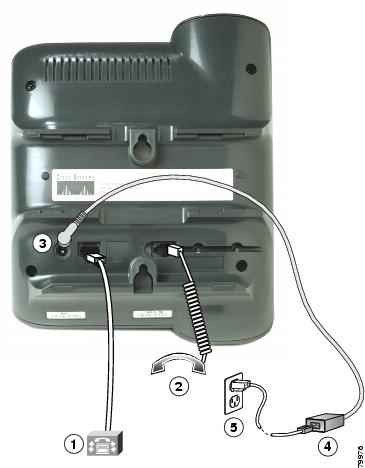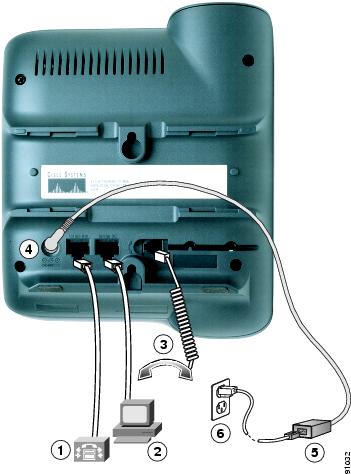

-
Cisco Unified IP Phone Model 7905G and 7912G Administration Guide for Cisco Unified CallManager Release 4.2 and later
-
Index
-
Preface
-
Overview of the Cisco Unified IP Phone
-
Preparing to Install the Cisco Unified IP Phone on Your Network
-
Setting Up the Cisco Unified IP Phone
-
Configuring Network Settings on the Cisco Unified IP Phone
-
Configuring Features, Services, Templates, and Users
-
Viewing Status, Statistics, Model, and Firmware Information on the Cisco Unified IP Phone
-
Troubleshooting the Cisco Unified IP Phone
-
Additional Configuration Methods and Parameters
-
Providing Information to Users Via a Website
-
Supporting International Users
-
Updating Firmware for the Cisco Unified IP Phone
-
Changing the Graphic on the Cisco Unified IP Phone Screen
-
Technical Specifications
-
Table Of Contents
Setting Up the Cisco Unified IP Phone
Cisco Unified CallManager Configuration
Understanding the Cisco Unified IP Phone 7905G and 7912G Components
Installing the Cisco Unified IP Phone
Mounting the Phone to the Wall
Verifying the Phone Startup Process
Configuring Startup Network Settings
Setting Up the Cisco Unified IP Phone
This chapter includes the following topics, which help you install the Cisco Unified IP Phone on an IP telephony network:
•
Understanding the Cisco Unified IP Phone 7905G and 7912G Components
•
Mounting the Phone to the Wall
•
Verifying the Phone Startup Process
•
Configuring Startup Network Settings
Note
Before you install a Cisco Unified IP Phone, you must make some critical decisions about how to configure the phone in your network. You can then safely install the phone and verify its functionality. For information on preparing to install, see Chapter 2, "Preparing to Install the Cisco Unified IP Phone on Your Network."
Before You Begin
Before installing the Cisco Unified IP Phone, review the requirements in these sections:
•
Cisco Unified CallManager Configuration
Network Requirements
For the Cisco Unified IP Phone to successfully operate as a Cisco Unified IP Phone endpoint in your network, your network must meet the following requirements:
•
Working VoIP Network
–
Voice over IP (VoIP) configured on your Cisco routers and gateways
–
Cisco Unified CallManager Release 4.0 or higher installed in your network and configured to handle call processing
•
IP network that supports DHCP or manual assignment of IP address, gateway, and subnet mask
Cisco Unified CallManager Configuration
The Cisco Unified IP Phone requires Cisco Unified CallManager to handle call processing. Refer to Cisco Unified CallManager Administration Guide or context-sensitive help in the Cisco Unified CallManager Administration application to ensure that Cisco Unified CallManager is set up properly to manage the phone and to properly route and process calls.
Table 3-1 explains and provides references for many of the configuration activities for which you use Cisco Unified CallManager Administration.
Table 3-1 Cisco Unified CallManager Configuration Activities
Auto-registration.
If you plan to use auto-registration, verify that it is enabled and properly configured in Cisco Unified CallManager before connecting any Cisco Unified IP Phone to the network.
See the "Methods for Adding Phones to the Cisco Unified CallManager Database" section on page 2-9.
Configure and assign telephony features.
You must use Cisco Unified CallManager Administration to configure and assign telephony features to the Cisco Unified IP Phones.
See the "Telephony Features Using Cisco Unified CallManager Administration" section on page 5-2.
Add and associate users.
In Cisco Unified CallManager Administration, you can add users to the database and associate them with specific phones. In this way, users gain access to web pages that allow them to configure phone options such as call forwarding and speed dialing.
See the "Adding Users to Cisco Unified CallManager" section on page 5-15.
Safety
Review the following warnings before installing the Cisco Unified IP Phone. To see translations of these warnings, refer to the Regulatory Compliance and Safety Information for the Cisco Unified IP Phone 7900 Series document that accompanied this device.
Warning
Read the installation instructions before you connect the system to its power source.
Warning
Only trained and qualified personnel should be allowed to install, replace, or service this equipment.
Warning
Ultimate disposal of this product should be handled according to all national laws and regulations.
Warning
Do not work on the system or connect or disconnect cables during periods of lightning activity.
Warning
To avoid electric shock, do not connect safety extra low voltage (SELV) circuits to telephone network voltage (TNV) circuits. LAN ports contain SELV circuits, and WAN ports contain TNV circuits. Some LAN and WAN ports both use RJ-45 connectors. Use caution when connecting cables.
The following warnings apply when you use an external power supply.
Warning
This product relies on the building's installation for short-circuit (overcurrent) protection. Ensure that a fuse or circuit breaker no larger than 120 VAC, 15 A U.S. (240 VAC, 10 A international) is used on the phase conductors (all current-carrying conductors).
Warning
The device is designed to work with TN power systems.
Warning
The plug-socket combination must be accessible at all times because it serves as the main disconnecting device.
Understanding the Cisco Unified IP Phone 7905G and 7912G Components
The Cisco Unified IP Phone 7905G and 7912G include these components on the phone:
Network and Access Ports
The back of the Cisco Unified IP Phone 7912G has two RJ-45 ports. The network port is labelled "10/100SW" and the access port is labeled "10/100PC." The back of the Cisco Unified IP Phone 7905G has one RJ-45 network port.
The two ports on the Cisco Unified IP Phone 7912G each support 10/100 Mbps half- or full-duplex connections to external devices. The speed and connection type are set through auto-negotiation. The single port on the Cisco Unified IP Phone 7905G supports 10 Mbps half-duplex connections to external devices. You can use either Category 3 or 5 cabling for 10-Mbps connections, but you must use Category 5 for 100 Mbps connections.
Use the network port to connect the phone to the network. You must use a straight-through cable on this port. The phone can also obtain inline power from the Cisco Catalyst switch over this connection. See the "Providing Power to the Cisco Unified IP Phone" section on page 2-7 for details.
Use the access port to connect a network device, such as a computer, to the phone. You must use a straight-through cable on this port.
See Figure 3-1 for the connection port available on the back of the Cisco Unified IP Phone 7905G. See Figure 3-2 for the connection ports available on the back of the Cisco Unified IP Phone 7912G.
Handset
The handset is designed especially for use with a Cisco Unified IP Phone. It includes a light that indicates incoming calls and voice messages waiting.
Speaker
The Cisco Unified IP Phone 7905G and 7912G include a speaker that you can use to monitor calls.
To disable the speaker on these phones, choose Device > Phone from the Cisco Unified CallManager Administration application, locate the phone you want to modify, and check the Disable Speakerphone check box.
Installing the Cisco Unified IP Phone
To install the Cisco Unified IP Phone, perform the following steps. See Figure 3-1 and Figure 3-2 for graphical overviews of these steps.
Step 1
Connect the handset to the Handset port.
—
—
Step 2
Connect a Category 3 or 5 straight-through Ethernet cable from the switch to the network port on the phone.
Each Cisco Unified IP Phone ships with one Ethernet cable in the box.
See the "Network and Access Ports" section for guidelines.
Step 3
Connect a Category 3 or 5 straight-through Ethernet cable from another network device, such as a desktop computer, to the access port on the Cisco Unified IP Phone 7912G.
Optional. You can connect another network device later if you do not connect one now.
See the "Network and Access Ports" section for guidelines.
Step 4
Connect the power supply to the Cisco DC Adapter port.
Optional.
See the "Providing Power to the Cisco Unified IP Phone" section on page 2-7 for guidelines.
Figure 3-1 Cisco Unified IP Phone 7905G Cable Connections
Figure 3-2 Cisco Unified IP Phone 7912G Cable Connections
Mounting the Phone to the Wall
You can mount the Cisco Unified IP Phone on the wall by removing the footstand and using the mounting bracket on the back of the phone, or you can use special brackets available in a Cisco Unified IP Phone wall mount kit. (Wall mount kits must be ordered separately from the phone.) If you attach the Cisco Unified IP Phone to the wall using the standard footstand and not the wall mount kit, you need to supply the following tools and parts:
•
Screwdriver
•
Screws to secure the Cisco Unified IP Phone to the wall
Use the following procedure to mount the phone on the wall using its mounting bracket.
Before You Begin
To ensure that the handset attaches securely to a wall-mounted phone, remove the handset wall hook from the handset rest, rotate the hook 180 degrees, and reinsert the hook. Turning the hook exposes a lip on which the handset catches when the phone is vertical. For an illustrated procedure, refer to Installing the Universal Wall Mount Kit for the Cisco Unified IP Phone.
CautionUse care not to damage wires or pipes located inside the wall when securing screws to wall studs.
Procedure
Step 1
Remove the footstand from the phone.
Step 2
Modify the handset rest so that the handset remains on the ear-piece rest when the phone is vertically placed.
Step 3
Insert two screws into a wall stud, matching them to the two screw holes on the back of the phone.
The keyholes fit standard phone jack mounts.
Step 4
Hang the phone on the wall.
Verifying the Phone Startup Process
After the Cisco Unified IP Phone has power connected to it, the phone begins its startup process by cycling through these steps.
1.
The handset light strip, Hold button, and Menu button flash on and off simultaneously.
2.
The phone screen displays the Cisco Systems, Inc., copyright screen.
3.
The phone screen displays these messages as the phone starts up:
•
Configuring VLAN
•
Configuring IP via DHCP
•
Configuring CM List
•
Opening address (where address is the IP address of the Cisco Unified CallManager server)
•
Registering
4.
The main phone screen displays:
•
Current date and time
•
Primary directory number
•
Softkeys
If the phone successfully passes through these stages, it has started up properly. Otherwise, see to the "Resolving Startup Problems" section on page 7-2.
Configuring Startup Network Settings
If you are not using DHCP in your network, you must configure these network settings on the Cisco Unified IP Phone after installing the phone on the network:
•
IP address
•
IP subnet mask
•
Default gateway IP address
•
Domain name
•
DNS server IP address
•
TFTP server IP address
Collect this information and follow the procedures defined in Chapter 4, "Configuring Network Settings on the Cisco Unified IP Phone."

 Feedback
Feedback



